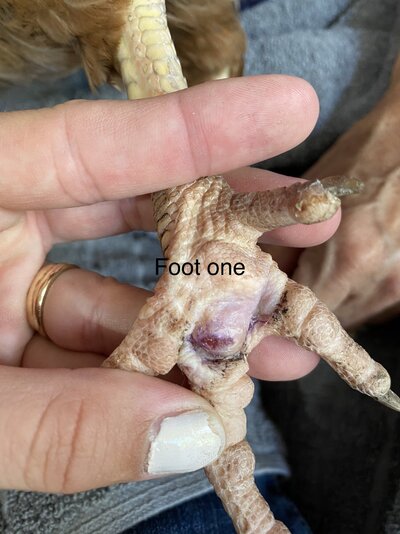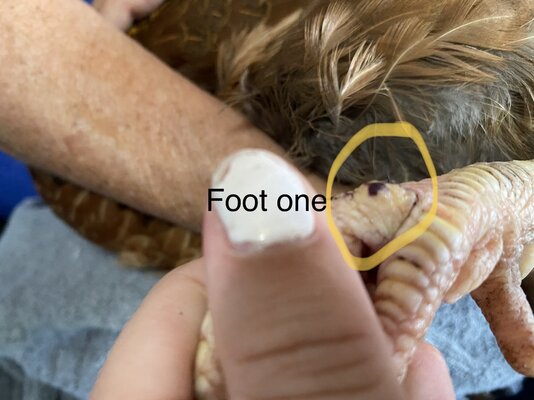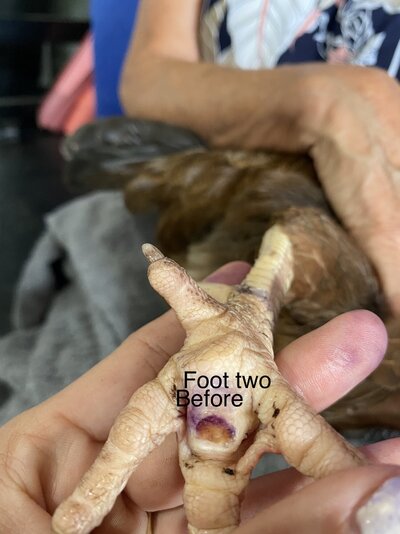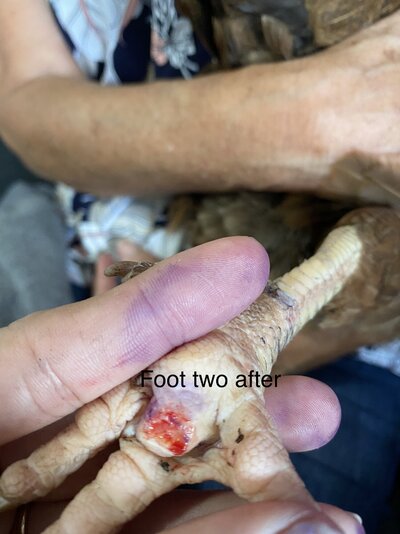JennSchurke
In the Brooder
- Apr 8, 2020
- 10
- 3
- 26
Hi! I’ve read through a few articles and have limited confidence regarding my Welsummer chicken (1.5yr old) bumble foot on both feet.
My neighbor had claimed she cured hers and I’m getting nervous bc her methods weren’t entirely what I read.
I wanted to ask for advice moving forward (we are 10 days in since we cut out and bandaged the black scab of both her feet, checking and rewrapping every two days).
I was under the impression I should cut out the black after cleaning with hydrogen peroxide, soaking with epsom and rewrapping after spraying blue wound spray and checking every two days for extra growth and retaking out any new black. The bubble on the top of their feet were just to be used a stringed on to see if anything would come out. She decided to slice the top bubble on one and told me a syringe wouldn’t bring anything out. She pushed a kernel through that one, very small. It is now healing grossly. It’s swollen and hard and has a black top scab that’s very hard and raised. It feels like something hard is in it. She said it’s a kernel and that it will work it’s way down through the hole at the bottom of the foot? That’s what her chickens did and it was a long narrow kernel and THEN chicken started to heal. She then said that her chicken still has a small black scab at bottom of foot 3 months later and she thinks that’s just how chickens heal.
I read nothing about kernels and only that every two days you unwrap, clean, scrap any more black that’s grown and rewrapping after putting on blue wound care and that it will take 10 or so days.
Am I naive??
Current status: 10 days in from discovering Phase 1 bumble foot (by a chart I found) on both my Welsummer feet. One foot we took out the black scab, somewhat deep and bandaged up. One foot we took out the black scab and also sliced open and popped a kernel out the top bubble.
it’s day 10 and I’m attaching pictures of the first foot with the bottom I haven’t touched anymore and the top I haven’t touched. I’m also attaching pictures of the second foot that just today I scapeled off some black at the top of the wound scanning but effectively everything else looked like normal flesh? But had some hardened maybe yellow spots that I thought might be the kernel my neighbor was referencing.
1. anything about these pictures show obvious issues I need to address/am missing?
2. Is my method way off base
3. Are kernels something I should be cutting/popping out like my neighbor said? Am I right to be concentrating on removing the black if it regrows?
so grateful for any input and apologies in advance if I’m unnecessarily hurting this chicken and need to readjust. I will immediately. This is my third yr with chickens and I’ve never encountered illness, I guess have gotten lucky. I feel horrible that my girl is having to be my guinea pig.
My neighbor had claimed she cured hers and I’m getting nervous bc her methods weren’t entirely what I read.
I wanted to ask for advice moving forward (we are 10 days in since we cut out and bandaged the black scab of both her feet, checking and rewrapping every two days).
I was under the impression I should cut out the black after cleaning with hydrogen peroxide, soaking with epsom and rewrapping after spraying blue wound spray and checking every two days for extra growth and retaking out any new black. The bubble on the top of their feet were just to be used a stringed on to see if anything would come out. She decided to slice the top bubble on one and told me a syringe wouldn’t bring anything out. She pushed a kernel through that one, very small. It is now healing grossly. It’s swollen and hard and has a black top scab that’s very hard and raised. It feels like something hard is in it. She said it’s a kernel and that it will work it’s way down through the hole at the bottom of the foot? That’s what her chickens did and it was a long narrow kernel and THEN chicken started to heal. She then said that her chicken still has a small black scab at bottom of foot 3 months later and she thinks that’s just how chickens heal.
I read nothing about kernels and only that every two days you unwrap, clean, scrap any more black that’s grown and rewrapping after putting on blue wound care and that it will take 10 or so days.
Am I naive??
Current status: 10 days in from discovering Phase 1 bumble foot (by a chart I found) on both my Welsummer feet. One foot we took out the black scab, somewhat deep and bandaged up. One foot we took out the black scab and also sliced open and popped a kernel out the top bubble.
it’s day 10 and I’m attaching pictures of the first foot with the bottom I haven’t touched anymore and the top I haven’t touched. I’m also attaching pictures of the second foot that just today I scapeled off some black at the top of the wound scanning but effectively everything else looked like normal flesh? But had some hardened maybe yellow spots that I thought might be the kernel my neighbor was referencing.
1. anything about these pictures show obvious issues I need to address/am missing?
2. Is my method way off base
3. Are kernels something I should be cutting/popping out like my neighbor said? Am I right to be concentrating on removing the black if it regrows?
so grateful for any input and apologies in advance if I’m unnecessarily hurting this chicken and need to readjust. I will immediately. This is my third yr with chickens and I’ve never encountered illness, I guess have gotten lucky. I feel horrible that my girl is having to be my guinea pig.




